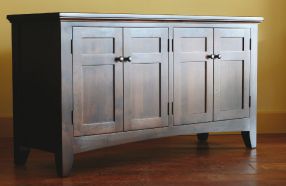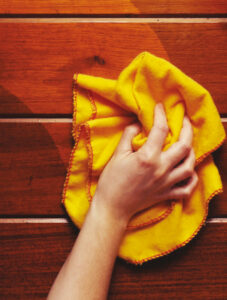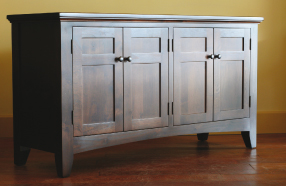In the Know With the Glow: Caring for Hardwood Furniture

 Whether you’ve just inherited a lovely wardrobe that’s been in your family for decades or you just bought a brand-new coffee table you had custom made for your living room, knowing how to properly care for hardwood furniture is a must. Merely reading the labels on those quick, spray-and-wipe polish cans won’t tell you everything you need to know—but the experts will.
Whether you’ve just inherited a lovely wardrobe that’s been in your family for decades or you just bought a brand-new coffee table you had custom made for your living room, knowing how to properly care for hardwood furniture is a must. Merely reading the labels on those quick, spray-and-wipe polish cans won’t tell you everything you need to know—but the experts will.
And that’s where you should start.
When you purchase fine furniture, ask for special care tips. Quality manufacturers want their products to last, so don’t hesitate to ask for their advice. But like a good stain, the advice they give might take some time to set in. You may have never heard of “paste wax” before, or that dusting with a feather duster isn’t the best idea. Follow manufacturers directions carefully and keep them for ready reference.
One key to kicking off your regular furniture care is to learn that cleaning/polishing furniture and dusting furniture are two separate chores. The experts at home-furniture-care.com say wood furnishings should be dusted regularly, “ideally, at least once a week.” Furniture manufacturers and restorers recommend using a clean, soft cotton cloth for dusting. That feather duster, though quick and easy if you’re hosting a dinner party in 10 minutes, will only relocate the dust. Although those handy, disposable duster mitts also help in a pinch, there is no need to purchase box after box, month after month. The American Hardwood Information Center suggests using an old T-shirt, diaper, cheesecloth, dish towel, piece of flannel or chamois. Do not use cloths with snaps, buttons, zippers or thick seams, they say, because they could cause scratches. The Center also recommends dampening the cloth before dusting, but only using a few drops of water. “The trick is to moisten the cloth just enough to make dust adhere to it,” the Center says on its website, hardwoodinfo.com. “The cloth should not be so damp that it wets the wood. If you can see any trace of water on the wood after you wipe, your cloth is too damp.” Distilled water is often recommended for heirlooms and antiques.
For tips on “Scratch and Nick First Aid,” and “Other Home Remedies,” go to HomeFurnish.com
(information provided compliments of the Hardwood Manufacturers Association).
If you dust regularly, the less frequent cleaning/polishing task should become easier. But you first must decide what cleaning product is the best—polish, oil or wax. The real question is whether you want a “clean shine” product or one that does double duty as a protector. On the Professional Restorers International website, restorer Steve Nearman, who has worked at several historic sites in Virginia, says spray-on polish and oils “give a quick temporary shine in just minutes, but that’s all you get. The reason they ‘shine’ is because they are WET. This ‘wet look’ may produce a nice shine but offers little or no protection.” That’s why he touts paste wax instead. “Many people, especially antique lovers, prefer the soft sheen provided by paste wax,” he says. “Also, waxes do not interfere with future refinishing like silicone polishes most often do. It requires effort, but you won’t obtain a more durable, beautiful protection than paste wax.” If used properly, he says, paste wax will produce a thin, durable finish of its own as it protects the furniture’s original finish. Because waxes dry hard and not wet like polishes, they don’t smear and attract dust and dirt all over again. The Hardwood Manufacturers Association recommends applying a paste wax every six to twelve months. Remember “wax on, wax off” from The Karate Kid? The HMA says old wax must first be removed with a mild, non-alkaline soap and water solution before you add a fresh coat of wax.
 If you do revert to oil-based finishes and polishes, experts warn against using products that contain silicone oil, which can seep through cracks in the finish and enter the wood, eventually ruining the new finish, according to the American Hardwood Information Center. With all the emphasis on “green cleaning” that is out there today, you may also want to try this recipe for furniture polish from ecocycle.org: Mix 2 tsp. lemon oil and 1 pint mineral oil in spray bottle. Spray, rub in and wipe clean. Or you can mix two parts olive oil to one part lemon juice; after rubbing the mixture in, let it stand for several hours and then polish with a soft, dry cloth.
If you do revert to oil-based finishes and polishes, experts warn against using products that contain silicone oil, which can seep through cracks in the finish and enter the wood, eventually ruining the new finish, according to the American Hardwood Information Center. With all the emphasis on “green cleaning” that is out there today, you may also want to try this recipe for furniture polish from ecocycle.org: Mix 2 tsp. lemon oil and 1 pint mineral oil in spray bottle. Spray, rub in and wipe clean. Or you can mix two parts olive oil to one part lemon juice; after rubbing the mixture in, let it stand for several hours and then polish with a soft, dry cloth.
With routine care, your oldest furniture and your newest can be your favorite household treasures. Protect the natural beauty of your hardwood furniture and let it shine for a lifetime and beyond.






